| Columns Retired Columns & Blogs |
Thiel CS3.7 loudspeaker Measurements
Sidebar 3: Measurements
The Thiel CS3.7's voltage sensitivity is specified as 90dB/2.83V/m. My B-weighted estimate on its tweeter axis, assessed with DRA Labs' MLSSA system, was slightly above that figure, at 90.7dB(B)/2.83V/m. This may well have been affected by the Thiel's frequency response (see below). The sensitivity is usefully higher than average, which is a good thing considering that the CS3.7's impedance remains between 2 and 3 ohms over much of the audioband (fig.1), and that there is a demanding combination of 3.8 ohms and –40° capacitive phase angle at 60Hz. Thiel specifies the impedance being nominally 4 ohms, with a minimum of 2.8 ohms. I actually found the minimum impedance to be 2.4 ohms at 125Hz. The difference between 2.8 and 2.4 ohms is academic, either mandating use of an amplifier that has no problem delivering high currents.
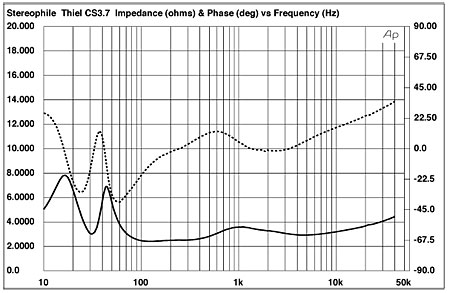
Fig.1 Thiel CS3.7, electrical impedance (solid) and phase (dashed). (2 ohms/vertical div.)
The traces in fig.1 are smooth, but I did find a couple of resonant modes in the cabinet's walls. Fig.2, for example, is a cumulative spectral-decay plot calculated from the output of an accelerometer fastened to the sidewall below the cast-aluminum dome 10" from the top. The modes are both low in level and high in frequency, both of which will minimize any audible effects they might have.
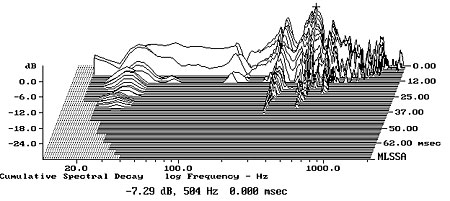
Fig.2 Thiel CS3.7, cumulative spectral-decay plot calculated from output of an accelerometer fastened to center of side panel 10" from top (MLS driving voltage to speaker, 7.55V; measurement bandwidth, 2kHz).
With a speaker such as the CS3.7, which has a sloped baffle and first-order crossover filters, it is important to measure its frequency response on the optimal axis, which is where the outputs of the multiple drive-units arrive at the ear or microphone at the same time. I use a speaker's step response to investigate this aspect of a speaker's operation; fig.3, for example, shows the CS3.7's step response at a distance of 50" on its tweeter axis. The sharply defined, positive-going attack at 3.8ms is the output of the coaxial tweeter and midrange unit, but its output is rapidly dropping back toward the time axis by the time the output from the woofer arrives at the mike (the slower-rising, rounded peak between 4.2 and 5ms). This axis, which is 40" from the floor, is too high for the drive-unit outputs to integrate properly.
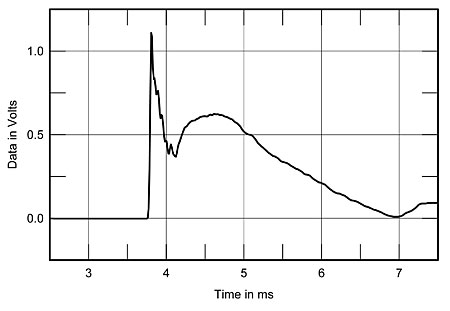
Fig.3 Thiel CS3.7, step response on tweeter axis at 50" (5ms time window, 30kHz bandwidth).
Moving the microphone down by 6" gives the step response shown in fig.4—though there is still a touch of overshoot evident on this axis, the outputs of all three drive-units arrive at the microphone at the same time, resulting in an excellent, time-coincident, right-triangle shape to the step response. Moving the microphone down even farther eliminates the overshoot, but slows the rise of the step's leading edge, due to the woofer's output now arriving a little earlier (not shown). I therefore used the axis 34" from the floor, where the speaker's output is time-coincident, for all subsequent measurements. This height is also close to the average listener ear height, which was investigated by Home Theater's senior editor Tom Norton when he worked for Stereophile in the mid-1990s. (Remarkably, he found that both tall and short people have their ears within a couple of inches of 36" from the floor when sitting in typical lounge chairs.)
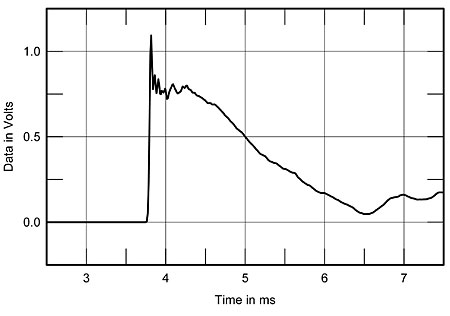
Fig.4 Thiel CS3.7, step response on tweeter axis at 50" (5ms time window, 30kHz bandwidth).
Fig.5 shows how the speaker's response changes above and below this axis. Basically, the higher you sit, the more you'll be bothered by a lack of energy in the crossover region between the woofer and midrange; the more you slouch below 34" from the floor, the more the speaker's balance will favor the lower mids rather than the treble.
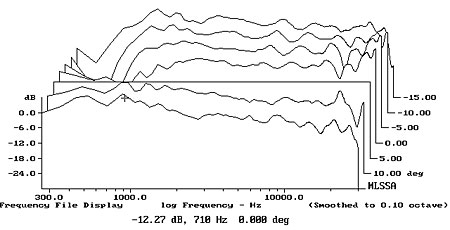
Fig.5 Thiel CS3.7, vertical response family at 50", normalized to response on listening axis (6" below tweeter), from back to front: differences in response 20–5° above axis, reference response, differences in response 5–10° below axis.
The black trace above 300Hz in fig.6 is the CS3.7's farfield response on this optimal axis, averaged across a 30° horizontal window. The response smoothly and gently slopes up between the midrange and the top octave. Not only will this boost the measured sensitivity a little (see Keith Howard's article on assessing loudspeaker sensitivity in Hi-Fi News, October 2008), but all things being equal, I would have thought it correlated with WP's observation that Thiel speakers tend toward "a hyperarticulation that a less charitable listener might call brightness." Except that he found that the CS3.7 didn't conform to that generalization. The black trace below 300Hz in fig.6 is the complex sum of the nearfield responses of the midrange unit (green trace), woofer (blue), and passive radiator (red). The peak in the midbass will be almost entirely due to the "2pi" boost that results from the nearfield measurement technique; the CS3.7 will be flat anechoically down to 35Hz or so, lower than I had anticipated from WP's auditioning notes. The crossover from the midrange to the woofer occurs around 300Hz, though the use of first-order filters results in a large amount of overlap, of course. The passive radiator is tuned to the frequency of the woofer's minimum-motion notch at 31Hz, with a well-defined bandpass output.
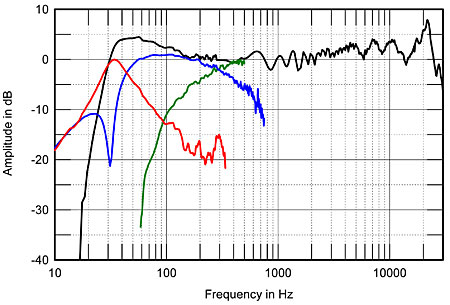
Fig.6 Thiel CS3.7, anechoic response on listening axis at 50" without grille (black), averaged across 30° horizontal window and corrected for microphone response, with the nearfield responses of midrange unit (green), woofer (blue), and passive radiator (red), plotted in the ratios of the square roots of their radiating areas below 500Hz, 750Hz, and 350Hz, respectively, and the complex sum of nearfield responses plotted below 300Hz (black).
A speaker's horizontal dispersion will also affect its perceived balance. The CS3.7's dispersion, shown in fig.7, is remarkably even between 800Hz and 10kHz, something that always correlates with stable, accurate stereo imaging. But it also means that the Thiel is putting out a lot of treble energy into the room; acoustically well-damped rooms will work better than live ones. WP's room is fairly large, with quite a lot of absorption at high frequencies. The Thiels' spatially averaged response in his room (fig.8) gently rolls off above 7kHz, due to the increasing absorption of the furnishings in this region, but is superbly smooth and even between 200Hz and 7kHz. The depression between 100 and 200Hz and the peak between 60 and 100Hz are room-acoustics effects that have not been eliminated by the spatial averaging, and the speakers roll off a little earlier in the low frequencies than I had expected from the quasi-anechoic measurement, confirming WP's feeling that the speaker falls a little short in the low bass.
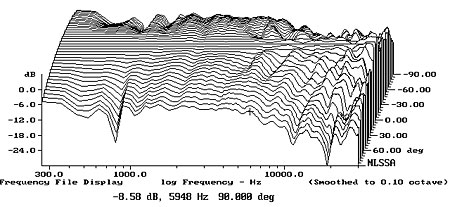
Fig.7 Thiel CS3.7, lateral response family at 50", normalized to response on listening axis, from back to front: differences in response 90–5° off axis, reference response, differences in response 5–90° off axis.
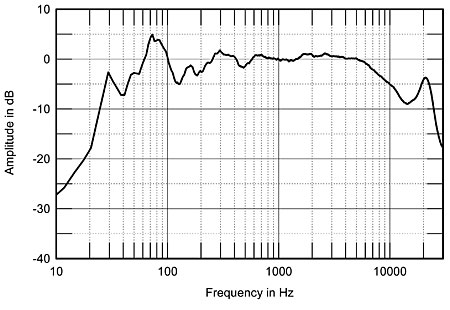
Fig.8 Thiel CS3.7, spatially averaged, 1/6-octave response in WP's listening room.
Finally, the CS3.7's farfield cumulative spectral-decay plot (fig.9) reveals a superbly clean, fast initial decay, though with some low-level hash visible in the treble.
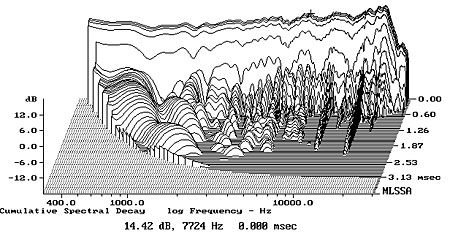
Fig.9 Thiel CS3.7, cumulative spectral-decay plot on tweeter axis at 50" (0.15ms risetime).
Speakers using first-order crossover filters have very often had some frequency-domain problems to put against their ability to present a time-coincident wavefront over a wide bandwidth. But the Thiel CS3.7 manages to offer the best of both worlds, and offers its owner some excellent speaker engineering in a beautifully finished package.—John Atkinson
- Log in or register to post comments




































